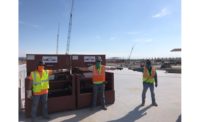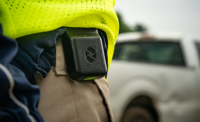March will mark one year since the first construction job site shutdowns. A lot has happened since then, yet the initial concerns about the COVID-19 pandemic’s impact on construction are still top of mind.
In a recent survey conducted during the ENR BuildTech pre-event webinar, “Building Through a Pandemic,” attendees were asked, “Back in March 2020, when the first shutdowns and shelter in place orders were issued in the U.S., what was your mindset at the time?” While 7% responded with “panic, an immediate need to perform triage to keep projects going,” 82% said they had “uncertainty, but expected to cope with the developing situation.” Another 10% responded that they were “already prepared for disruption and were ready to transition to new ways of working.”
It’s clear that the vast majority of businesses used the downtime to establish new jobsite protocols. When jobsites reopened last spring, those new protocols, along with fresh technologies were introduced. Site check in apps for health screenings via smartphones and QR codes have surged in popularity.
Now that design firms and construction companies have been working under new guidelines with these technologies for several months, longer-term benefits are surfacing. It turns out there’s a lot of insight to be gained from reading between the lines of QR codes. There are also risks.
Safe and Secure
Jobsite safety and security are increased through verified identification. Regular health checks keep jobsites from becoming super-spreader events for any virus. Digital records can provide proof to address union or OSHA issues. They also save time previously spent checking into a jobsite. Now they’re evolving into workforce management tools by capturing information about who is on a jobsite, where they’re working, what they’re doing, and who’s supervising them.
Over time, data collected during check-in can spot and proactively address project and workforce performance issues and trends. Applying analytics to this data will allow more effective management of resources during construction and also provide valuable insight when bidding future work. The new norm of maintaining 6 ft of social distancing is no doubt slowing work productivity for certain trades. The ability to gather information about employees’ whereabouts in real-time will allow contractors to more accurately budget their future costs and the amount of time to perform certain work until Covid-19 restrictions are removed.
On the other hand, while new technologies can boost real-time feedback, there are also legal considerations to using them. When an employee or visitor checks in, an employer must safeguard personally identifiable information and should not capture personal health information. While digital data collected by an employer is rightfully owned by an employer, its use and sharing must be access controlled.
Tracking and Contact Tracing
In the event of a viral outbreak, we know that time is critical for informing governments and workers or potential exposure. For residents of California, the new AB685 law requires notification within 48 hours.
Now that mass vaccinations have begun, employers need to be aware of the state and federal regulations and laws if they decide to require vaccinations for employees or even ask for proof of vaccination. Vaccination requirements vary based on a customer’s business and work environment. Employees working at a health care facility have been required to obtain certain vaccinations for employment. However, as with drug testing, federal employment law provides for exceptions based on health reasons or personal beliefs, so collecting such information requires caution.
Are You Covered?
A final example is the potential for an increase in inefficiency claims due to COVID-19 protocols. These claims typically arise when projects are significantly delayed and costs climb. If the parties’ contract does not address unforeseen circumstances [COVID-19 shutdowns and increased protocols], the responsibility for which party incurs these additional costs can quickly enter a gray area. It’s difficult to hold a general contractor accountable for state-mandated shutdowns. On the other hand, a shutdown could be due to a virus outbreak that’s tied to the jobsite. In these instances, a digital record of who was onsite when, where they worked, and the answers to health screening questions are critical.
This wouldn’t be the first time technology is a step ahead of regulations.
The point isn’t to scare people away from adopting new technology that’s going to make them more efficient, profitable and better able to support their workforce. Rather, it’s to be aware of the responsibilities of employers when they introduce these technologies into their workflows.
With site efficiency accelerated by the pandemic, there is reason to believe that the best is yet to come. Consumer smartphones and cloud computing show how rapidly digital technologies can be adopted once they are accessible and affordable to all levels of the workforce. Business-to-consumer usability will allow firms to adopt a broad menu of productivity and safety enhancing products from AI to AR, IoT to 5G, informatics to robotics, and others yet to be invented.
David Brian Ward is the founder and & CEO of Safe Site Check In. Brian Junginger’s practice at McInerney & Dillon in Northern California is focused primarily on construction litigation representing general contractors, subcontractors and sureties on public and private projects.




